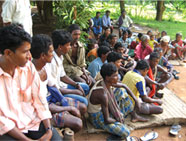Quick Links
Address
- N-2/152, Ground Floor,
- IRC Village, Nayapalli,
- Bhubaneswar, Odisha, India
- Tele.: +91 674 2553885
- nysasdri@gmail.com, nysasdri@yahoo.com
- Website:http://www.nysasdri.org


Figure: 1
Health is the state, when the potentials are able to satisfy the demands of life. This is expressed by the balance. If the potentials do not suffice to satisfy the demands of life, the state is disease.
The Meikirch Model is a description of the nature of health. It suggests that with the present budget governments and health workers could do much more for the health of the people than they do today. For this purpose they should focus more on the personally acquired potential and there by empower individuals to assume more responsibility for their health themselves.
The biologically given potential is largest at the time of birth, decreases throughout life and reaches zero at the time of death. The personally acquired potential is quite small at the time of birth, but it can grow throughout life provided a person is working for it. For two reasons the personally acquired potential is particularly important. First, as we grow older we depend more and more on the personally acquired potential. Second, the personally acquired potential is able to compensate in part for deficiencies of the biological given potential. These facts reveal that support of the personally acquired potential can do a lot to preserve the people’s health. Teaching in schools and through mass media should achieve much more importance in health care. Our experiences have shown that awareness of the people about the Meikirch Model increases their self-responsibility for health and makes health services more effective.
Figure 2:
In order to be healthy each human being has to fulfill all demands of life such as adequate nutrition, assurance of personal safety, hygiene, social integration and possibly procreation. For this purpose each human being has received abilities at birth and must also develop further abilities as life progresses. These abilities have to serve also in our future. Therefore they are called potentials. If the biologically given and the personally acquired potentials together suffice to cover all the vital demands of life a person is healthy. If they are insufficient she or he is diseased. Consequently, each individual has the responsibility to take good care of his or her biologically given potential and to continuously acquire new personally acquired.
Contributions by NYSASDRI The Meikirch Model has been introduced into village programs by NYSASDRI during the spring 2012. It was propagated in 100 villages with mostly indigenous inhabitants. The Model was introduced into an ongoing adult education program, which uses modern teaching techniques and assures that people themselves take all the decisions.
The Meikirch Model has been introduced into village programs by NYSASDRI during the spring 2012. It was propagated in 100 villages with mostly indigenous inhabitants. The Model was introduced into an ongoing adult education program, which uses modern teaching techniques and assures that people themselves take all the decisions.
Villagers listen to a NYSASDRI coworker who explains prospects offered by the Meikirch Model. Learning about the Meikirch Model the villagers recognized new opportunities and changed their attitudes. Their new understanding of health enabled them to do more for their health. People felt that health was not just a fate, but that they could assume responsibility for it. This resulted in a much higher motivation to become active.
The NYSASDRI personnel working in these villages found that the changed attitude was convincing to an extent that they themselves also became much more motivated. Of particular interest was the attitude of health workers. They are employed by the government to give health education, to assure mother/child care, to vaccinate all children, to distribute malaria- and iron tablets, and to refer diseased persons to health centers. These tasks were difficult because of the limited trust of the villagers. The health workers were then brought to NYSASDRI and were taught the Meikirch Model. As a result their effectiveness improved impressively. The new motivation of villagers was visible in the following fields:
The Meikirch Model is propagated also at higher levels such as district administrations, government of Odisha, national and international medical meetings. These activities were received with much interest at all levels.
The Meikirch Model is now also introduced into schools at three levels of teaching. It is assumed that this will help the children and later also the families they will form.
| ABOUT MEIKIRCH MODEL | ||
|